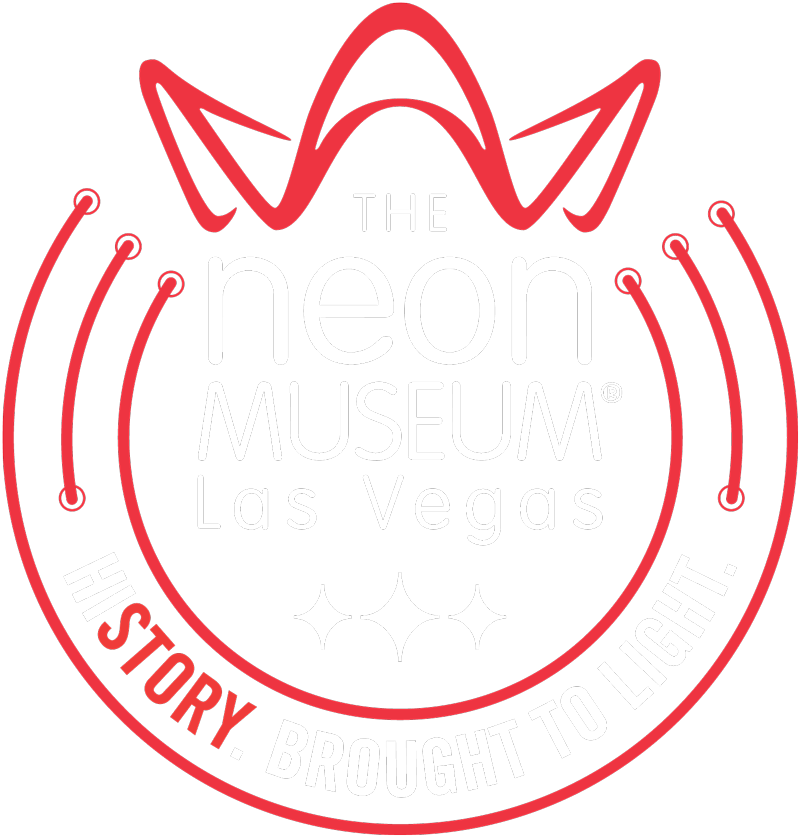How a neon sign in the middle of the road became a Las Vegas icon.
In the 1970s John Woodrum bought a motel on the edge of town, so far south on Las Vegas Boulevard that his wife joked it might be on the California side of the border. The Las Vegas Strip, as U.S. Route 91, was once the sole road into town from Southern California, but most drivers were now coming in on the new road, Interstate 15. The gateway to McCarran Airport used to be right next to Woodrum's motel, but that too had been bypassed by a newer entrance on Paradise Road. Further south of the motel, it was mostly wide-open desert. Sprawling communities like Enterprise and Silverado Ranch did not yet exist.
Out in the middle of the road, as viewed from Woodrum's motel, was the Welcome to Fabulous Las Vegas Nevada sign. It stood in darkness, its power shut off, looking like a relic from another era. How long had the power been off – weeks, months, years? And why? No one seemed to know.
Signs like these were already on the way out in the 70s. The Strip was beginning to be defined less by neon spectacles and more by high rise towers. The MGM Grand Hotel – then the newest, and largest hotel in the world – didn't bother with neon. Desert Inn would soon send its old neon sign off to the scrap pile.
But the Welcome sign wasn't forgotten and John Woodrum might have known this better than anyone. He watched daily as people stopped at his motel and raced across the open road for a picture with the sign. This was decades before it had its own driveway and parking spaces.
So Woodrum did what any proud new business owner would do with a dead landmark in front of the property. He ran a power line out to the sign and fired it up himself. Just like that, let there be light.
As the Welcome sign approaches its 60th anniversary, the lights are still on and it's never been more celebrated. It has become the undisputed symbol of Las Vegas, recognized around the world. It is the quintessential neon road sign and a staple of American culture.
Those who created the Las Vegas Strip dreamed big and planned for the future but there's no way they could have foreseen the longevity and iconic status of this one sign. So how did it come to be? We have surprisingly little to go on in answering that question.
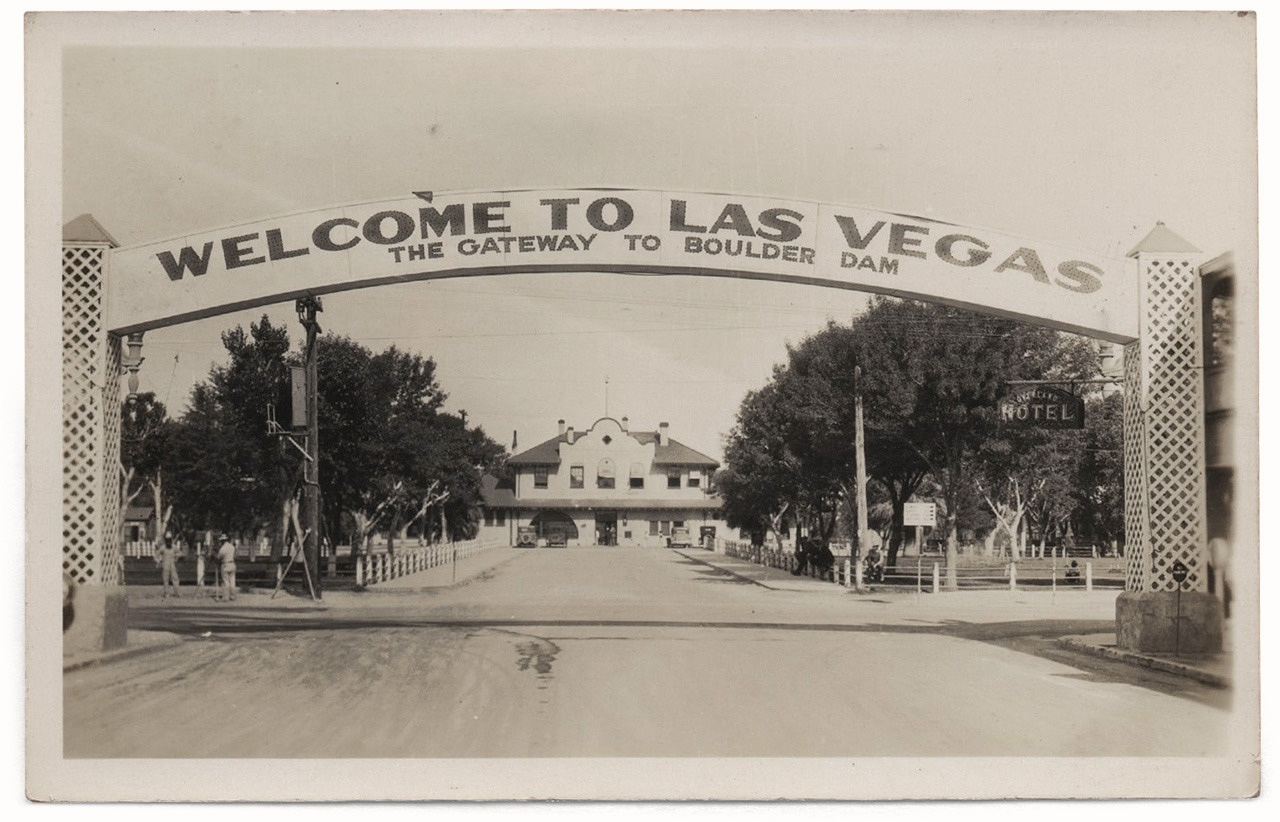 The first Welcome sign, Fremont & Main, c. 1930
The first Welcome sign, Fremont & Main, c. 1930
WELCOME TO ...
City markers and gateways have a history that stretches back centuries, but modern "Welcome" signs are the type developed in the age of the automobile. We see them through windshields - landmarks at the edge of town in all corners of the country, decorated with local symbols of culture, character and values. The gateway heading into old-time Greenville, TX proudly displayed their racism: "Welcome to Greenville - the blackest land - the whitest people."
Reno's arch, "The Biggest Little City in the West," was built in 1926 to commemorate a new highway. Just a few years later, Las Vegas made one of its own. Never mind that Las Vegas - a stop on the L.A.-Salt Lake Railroad with a population of a couple thousand - didn't appear on most maps in the 20s. Ripe with enthusiasm for construction of the dam, the city erected an arch over Fremont and Main by the depot that read, "Welcome to Las Vegas, Gateway to Boulder Dam." The sign was painted wood and enough of an eye-sore that neighboring hotel owners lobbied for its removal little over a year later.
By the late 50s, Las Vegas had come into its own and was no longer a railroad town. Travel by air and automobile was booming, car culture was in its prime. Those driving in from Los Angeles on Hwy 91 found motels, resorts, and casinos lining the Strip all the way from the airport to downtown. Fifty years after the birth of the city, it was as if the perfect place for a city marker had suddenly emerged.
Whose idea was it to make the Welcome sign and place it there by the airport? Here, at the beginning of the story, we rely on anecdotes passed down over the decades. Most say it was Ted Rogich from a small local company called Western Electric Displays Inc, aka Western Neon, that sold the idea to Clark County. Another story has it the other way around, with a group of hotel and casino owners approaching Rogich. Either way, the first record we have of the idea is in Clark County's Board of Commissioners meeting, Feb. 5, 1959, where a representative of Western presented the idea. The location of the sign was already established. The idea was approved by county commissioners and would be put out for bids. Western and their larger competitor, Young Electric Sign Co (YESCO), both bid for the job, with Western's offer of $4000 winning approval in April. The design itself was approved on May 5th. We shall have a sign.
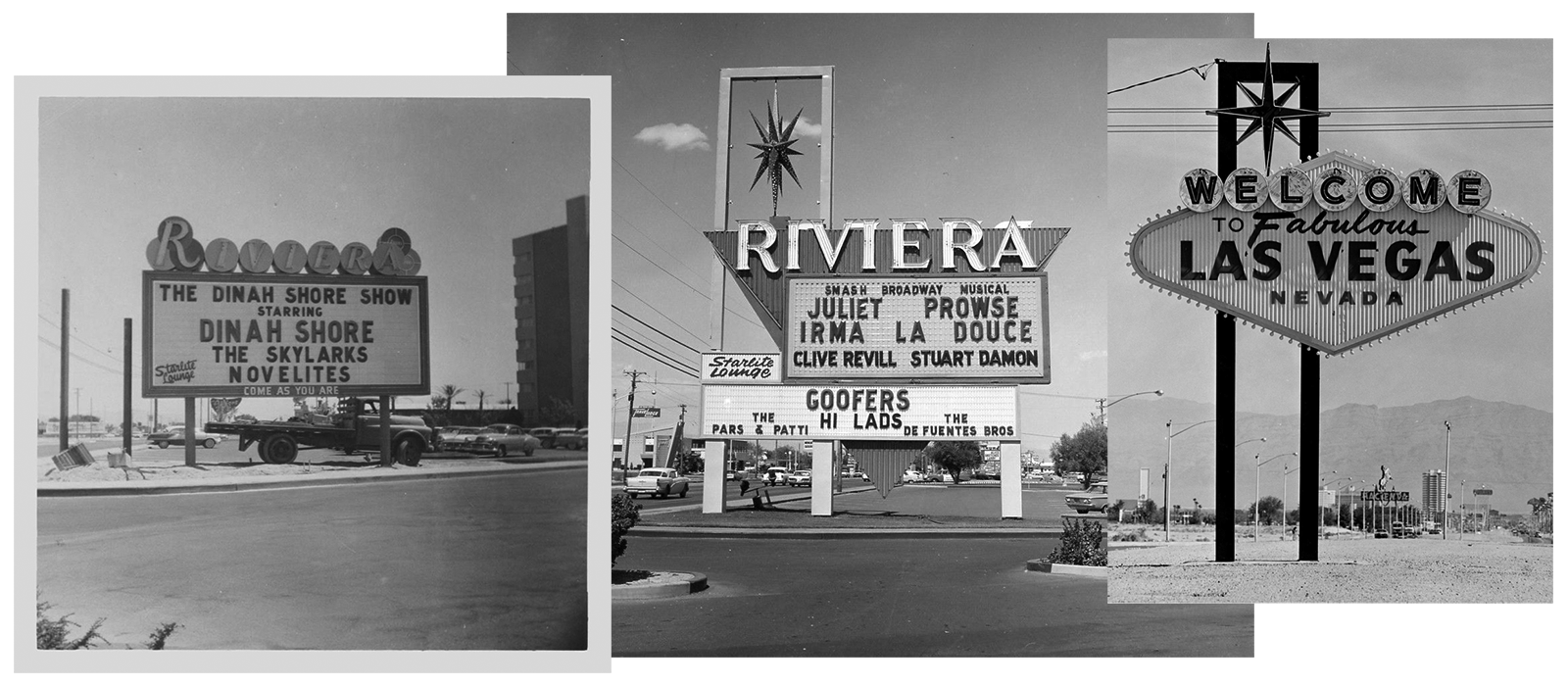
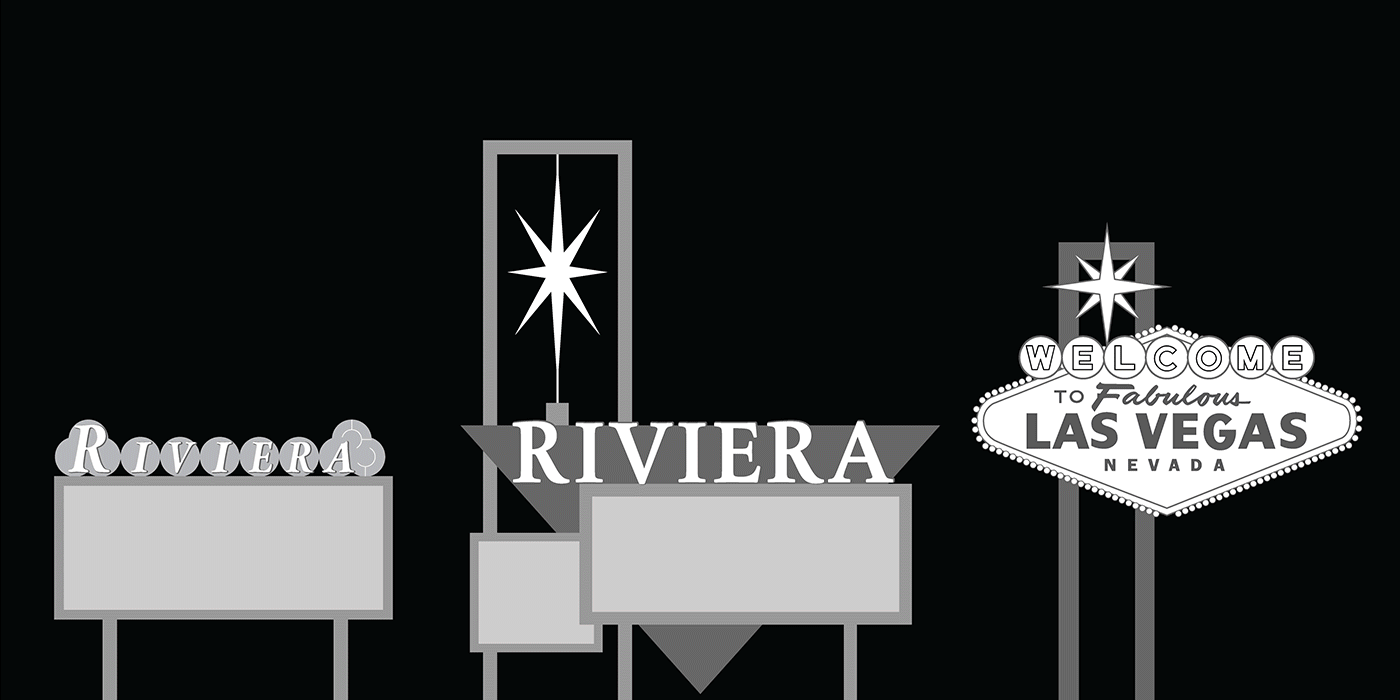 Riviera, 1955, designer unknown; Riviera, 1957, designer unknown; Welcome, 1959, Betty Willis
Riviera, 1955, designer unknown; Riviera, 1957, designer unknown; Welcome, 1959, Betty Willis
BETTY
“They wanted something that would identify Las Vegas and be as exciting and welcoming as they could get. We put flashing lights, chasing neon, and everything we could to put action into it. The whole theme of the sign was to make people feel welcome.”
Betty Willis designed the sign, and this was the story she told about its creation decades after the fact. Betty is a beloved and unique figure in Las Vegas history. She didn't design hotels or the tallest signs, didn't hang out with Frank, Dean, or Sammy, carry a black bag of cash for the mob. She was a graphic designer, who worked with a pencil, paper, and ruler. We love the sign, so we love Betty.
She gained fame for the Welcome sign late in life, and was given the rare opportunity to tell her own story, which she did well in many interviews. When she died in 2015 these stories ran in obituaries published all over the county, from The Los Angeles Times, to The New York Times, and everywhere in between.
Some of the stories seem like the usual telling Las Vegas history itself, gleefully unconcerned with detail. When it comes to describing ideas behind her iconic design she says, “I added a Disney star on top for happiness and designed a shape that would be unusual ... We knew the sign would be recognizable because of the odd shape."
But the “Disney star” was already a staple of commercial signage by the late 50s. Stars and sputniks shined all up and down Fremont Street and the Strip, on motels, restaurants, service stations, and casinos – the brightest one of all at the top of The Mint (YESCO, 1957). This doesn't take away from Willis' creation. I believe the strength of the Welcome sign has less to do with its unique innovation and more to do with what it adapted from the best.
There were ten to fifteen companies making neon signs in late 50s Las Vegas from Utah-based YESCO, already decades in the business, to locals like Western with a small crew and one shop at 1611 Mojave Drive where the Welcome sign was manufactured. Competition and influence is evident in the work. Each sign seemed to inch higher than the other with bigger stars and arrows and more exaggerated shapes. In the Welcome sign itself, one can find a lineage of design elements.
The letters W-E-L-C-O-M-E are presented as silver dollars, the coins that promised to come cascading from one of Vegas' lucky slot machines. The same motif was used in 1955 at the Riviera, whose first sign spelled R-I-V-I-E-R-A on casino chips. Riviera's second and more flamboyant sign from 1957 is this one that serves as the clearest inspiration to the Welcome sign: an angular double column topped with a star and an offset-mounted geometric-shaped board.
Willis said the inspiration for the sign's stretched diamond shape came from the Goodyear logo of the era. The shape might have also been familiar to her and to hotel and motel customers all over the country in the 1950s as the standard hotel key fob.
Were motifs like these purely coincidental or conscious? We may never know.
We may also never know exactly when the sign was installed. There were no photographs, no ceremony and no mention of the city's new welcome sign in any of the papers.
Western Neon was sold to YESCO a few years later. No one called to tell Betty. She wasn't a part of the sale. She was out of a job.
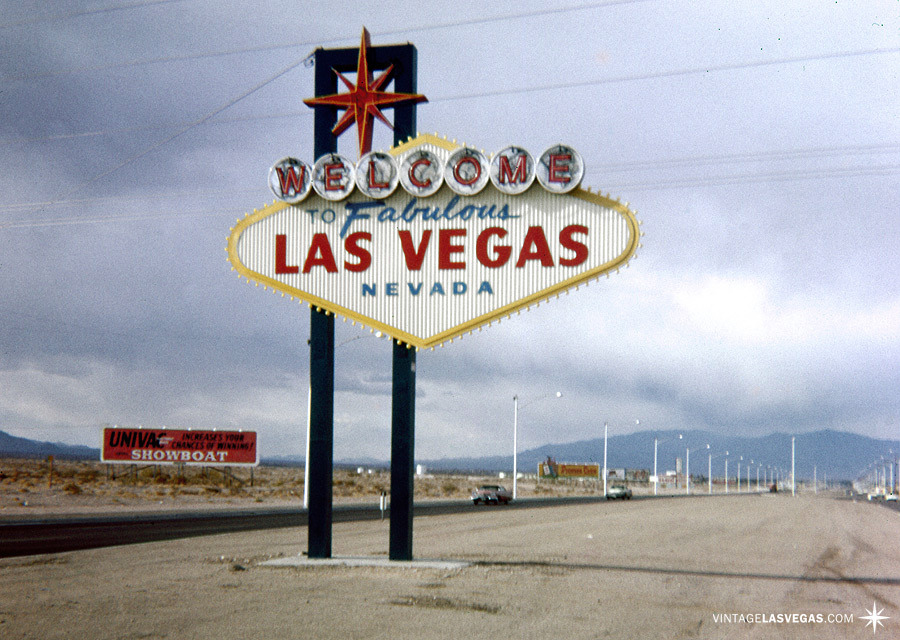 Tourist photo, September 1959, Vintage Las Vegas collection
Tourist photo, September 1959, Vintage Las Vegas collection
THE CENTENNIAL
Ray Dennis Steckler was a low-budget filmmaker based in Las Vegas whose movies ranged from campy horror, to travelogue, to porn - sometimes all at once. Summer of 1965 he was the cameraman on a sexploitation thriller called “The Velvet Trap”. He shot a scene where the frame opens on a car coming down a long highway. The camera turns, following the car as it passes, and ends with a close-up on the Welcome to Fabulous Las Vegas sign – its big screen debut.
In the early years the sign shows up in snapshots and 8mm home movies taken by travelers – the kinds of people who parked at John Woodrum's motel, or simply stopped in the middle of the road because there was so little traffic. Through the years in these travel photos we see new buildings popping up in the distance and little changes made to the sign by generations of maintenance crews. Later, the sign shows up on home movies shot on VHS, with mega-resorts in the background. The sign begins appearing as a kind of unofficial Sin City logo in scattered news and travel photos in the 60s and 70s eventually landing on the local phone book cover. It slowly grows in visibility, appearing in TV shows, music videos, video games and everything else.
Today the sign is adapted, copied and used on every possible thing you can think to sell, from the tacky to the sincere. Betty Willis herself once kept a scrapbook of these adapted uses but there would soon be too many to follow. Even the accolades were overwhelming. “People always want me to take pictures in front of the sign with showgirls or something,” she said, “it gets to be a burden.”
In the early 2000s, the Welcome design was used on a Nevada license plate, a charitable initiative supporting activities for the Las Vegas Centennial. This may have been the first time the public recognition of the sign could really be measured and the effort was a bonanza raising tens of millions of dollars which are used for cultural and historical programs to this day. (Ms. Willis had one of these plates on her car – hers read, MYSGN.) Safe and legal public access to the sign was finally made possible in 2008 with the construction of parking spaces and a pedestrian walkway. Clark County and the Nevada State Historic Preservation Office succeeded in having the sign listed on the National Register of Historic Places in 2009. On the morning of October 2nd, 2017, the day after the Route 91 shooting, it became a spontaneous memorial further illustrating the importance of the sign.
There isn't any one time when the sign became the icon. It happened slowly over time by pure endurance until everything else was blown up and it became the last piece of the fabulous 50s left standing. Even Mr. Woodrum's motel, the Klondike Inn, has been gone for more than a decade. Much of the original Welcome itself sign was rebuilt with sturdier materials in the factory at YESCO, who took ownership of the sign with their purchase of Western Neon, and has maintained it ever since in a contract with the county. I'm told of efforts to tear down and replace the sign in the 70s, 80s and 90s that were thwarted by public outcry. These stories are hard to verify and true as they may be, come across sounding like legends of survival in a town once all too willing to dispose of its history. Perhaps the thing that most helped the sign survive was that it was built out on the fringe, on a small piece of land in the middle of the road.
Until that time comes when they blow it up and build a high rise in its place, drive carefully, come back soon.
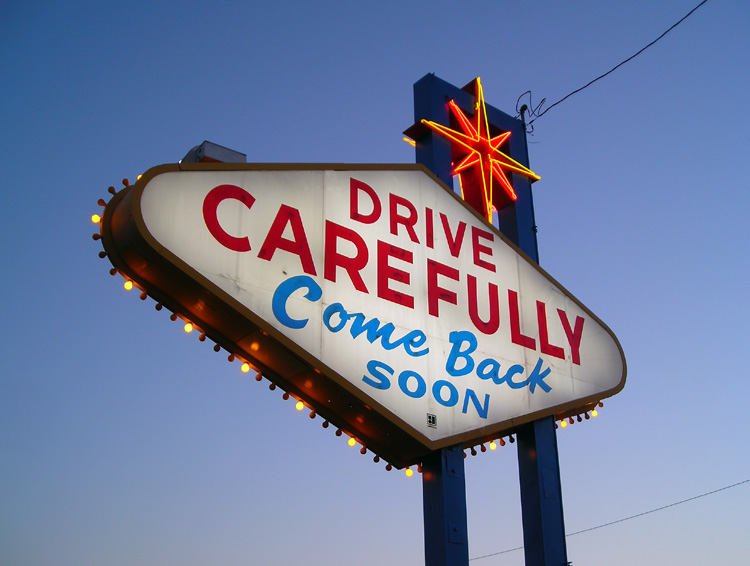 2006, by Allen Sandquist
2006, by Allen Sandquist
Thanks to those who have written about the sign and its players over the years. Sources used for this article include: Clark County Commission Meeting Minutes, Feb. 5, Apr. 20, May 5, 1959; "Welcome to Fabulous Las Vegas" National Register of Historic Places Registration Form, by Dorothy Wright and Angela Moor; Interview with Betty Willis, from "My Week at the Blue Angel," by Matthew O'Brien; "At his Klondike Hotel or the Welcome to Fabulous Las Vegas sign, John Woodrum kept the lights on," by John Katsilometes, Las Vegas Sun, Jan. 6, 2014; Interviews with Marjorie Holland, and Kent Carmichael, 2018.
